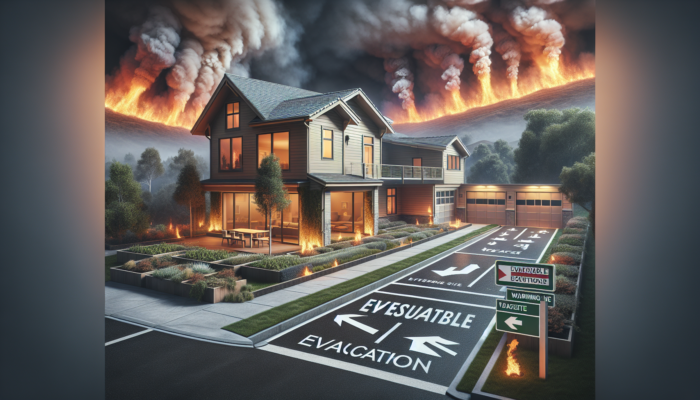Create Your Ultimate Wildfire Evacuation Plan: Essential Steps to Ensure Your Safety and Preparedness
As the incidence of wildfires continues to increase, developing a comprehensive wildfire evacuation guide becomes imperative for protecting your health and well-being. Being prepared is not just advantageous; it is essential for effectively responding to emergencies when they arise. Understanding the various risks associated with wildfires and crafting a robust evacuation plan can dramatically affect the outcomes during these perilous situations. This guide is designed to provide you with critical insights and proactive approaches, empowering you to face wildfire crises confidently and clearly.
Understanding Wildfire Risks: A Comprehensive Evaluation of Your Community’s Vulnerability

To effectively prepare for wildfires, you must first conduct an in-depth evaluation of the specific wildfire risk present in your locality. Certain areas are naturally more prone to wildfires, influenced by factors such as climate conditions, types of vegetation, and their proximity to natural reserves. Acquiring local fire risk maps and resources offered by fire departments or environmental organizations is crucial. By identifying vulnerabilities related to your property—such as the types of nearby vegetation, the characteristics of the terrain, and historical fire incident data—you can significantly enhance your readiness for any impending threats.
Levels of community preparedness can vary greatly, so having a thorough understanding of your local environment allows you to gauge how quickly a fire may spread. For example, regions abundant in brush or dense trees face a heightened risk compared to those with open landscapes. Understanding prevailing wind patterns is also vital for predicting the behavior of an encroaching wildfire. Local fire departments frequently conduct extensive assessments that provide valuable insights, thereby enhancing your preparedness strategies.
Formulating an Effective Evacuation Plan: Step-by-Step Guide for Safe and Efficient Departure
Creating a well-organized evacuation plan is crucial during any wildfire emergency. Begin by identifying clear and accessible evacuation routes, keeping in mind the potential for road closures due to fire activity or the presence of emergency responders. It is advisable to outline at least two distinct escape routes to guarantee a swift exit, even if one route becomes blocked or inaccessible.
Involve all family members in the planning process, highlighting the importance of adhering to the plan during crises. Regularly practice your evacuation routes, especially with children and elderly family members who may require additional assistance. Designate a safe meeting point outside the danger zone, ensuring everyone knows where to regroup if separated during the evacuation.
Finally, keep your evacuation plan current. Changes in family dynamics, the addition of new pets, or the identification of new hazards in your environment may necessitate adjustments to your evacuation strategy. Consistently reviewing and rehearsing your plan will instill confidence among all family members, ensuring they feel prepared should evacuation become necessary.
Creating a Comprehensive Emergency Kit: Essential Supplies for Swift Escapes
An emergency kit is a crucial element of your wildfire evacuation guide. This kit should be equipped with vital supplies to sustain you and your family for at least 72 hours away from home. Start by gathering essential items such as water, non-perishable food, and a first-aid kit. Additionally, include personal hygiene products, flashlights, extra batteries, and any necessary medications required by family members.
Consider the specific needs of your household: if you have infants, ensure baby formula and diapers are part of your kit. It is also important to pack critical documents such as identification, insurance papers, and medical records, ideally stored in a waterproof container for protection. Having a spare set of clothing and sturdy shoes for each family member is advisable to ensure their comfort during evacuation.
Don’t overlook comfort items like blankets and toys for children, as these can provide emotional support during stressful situations. Regularly inspect and refresh your emergency kit, ensuring that all items are in good condition, not expired, and readily available for immediate use when the need arises.
Enhancing Your Home’s Resilience Against Wildfire Threats: Proven Strategies for Protection

Preparing your home to withstand potential wildfire threats not only enhances your personal safety but also improves the likelihood that your property will survive a fire incident. Implementing protective measures can significantly reduce damage and facilitate a smooth evacuation process.
Strengthening Your Property: Proven Measures to Secure Your Home Against Wildfires
To enhance your home’s defense against wildfires, you must undertake a series of proactive measures. Start by establishing a defensible space around your property, which involves removing dead vegetation, trimming overhanging trees, and maintaining a safe distance between your home and any flammable materials. The recommended defensible space typically extends at least 30 feet from your residence, but in high-risk zones, you may need to increase this distance even further.
Consider utilizing fire-resistant materials for your roofing and siding. Options such as metal roofing, stucco, or brick exteriors can significantly enhance your home’s resilience to flames. Additionally, installing dual-pane windows provides extra protection against heat and embers. Regular maintenance is essential; ensure that gutters and roofs are routinely cleaned to prevent debris build-up that could ignite during a fire.
Lastly, ensure your property offers adequate access for emergency responders. Wide driveways and clear pathways facilitate quicker responses from firefighting teams if they need to protect your home from advancing flames.
Managing Utilities During Wildfire Evacuations: Safely Turning Off Gas, Electricity, and Water
Effectively managing utilities during a wildfire evacuation is vital to minimize further hazards. Before evacuating, familiarize yourself with the proper procedures for safely shutting off your gas, electricity, and water. These actions can significantly reduce the risk of fires igniting on your property after you leave.
Start with the gas lines; locate your gas meter and understand how to turn it off safely. If you are unsure, contact your utility provider for guidance on executing this task. For electricity, switch off breakers to prevent power surges that could occur when the system is reactivated. This precaution is particularly crucial if you reside in an area where electrical lines may fall during a wildfire.
Shutting off your water supply can also help prevent flooding in the event that pipes burst while you are away. Ensure you know where the appropriate shut-off valves are located and that all family members are trained to perform these essential tasks efficiently.
Creating a Detailed Inventory: Documenting Your Belongings for Safety and Recovery

Maintaining a comprehensive inventory of your belongings can prove invaluable in the event of a wildfire. Documenting your possessions not only aids in insurance claims but also facilitates a smoother recovery process after evacuation. Start by photographing or videotaping every room in your home, ensuring that you capture valuable items and their conditions in detail.
Store this documentation in an easily accessible location, such as a cloud storage service or a fireproof safe. Include receipts or appraisals for high-value items, as these documents can substantiate your claims during the recovery process.
Regularly update your inventory to reflect new purchases or changes in your household. This practice not only aids in recovery after a disaster but also encourages periodic assessments of your possessions’ value, which can be beneficial for insurance purposes and future planning.
Acting on Wildfire Evacuation Protocols: Essential Steps During an Evacuation Alert
When an evacuation alert is issued, taking swift and decisive action is critical. Knowing how to respond and maintaining clear communication can greatly enhance safety during these crucial moments.
Staying Informed: Utilizing Alerts and Monitoring Fire Progress Effectively
Staying updated is vital for your safety and preparedness during crises. Make use of local news outlets, social media platforms, and official government websites to monitor fire progression and evacuation orders. Many regions have established dedicated alert systems that send notifications via text or email, ensuring you receive timely updates about your situation.
Moreover, applications designed for emergency management can deliver real-time information regarding wildfires, including maps that indicate current fire locations, ongoing containment efforts, and suggested evacuation routes. Prioritize downloading relevant applications and enrolling in alerts when you recognize potential wildfire threats in your vicinity.
Furthermore, a battery-operated radio can act as a reliable backup for receiving information if power outages occur. Always plan to communicate with family members, ensuring that everyone understands how to stay informed during a crisis.
Establishing Robust Communication Plans: Keeping in Touch with Family and Neighbors
Creating a solid communication plan is essential during evacuation scenarios. Designate a primary contact for family members who may become separated during an emergency. Ensure that everyone has access to each other’s phone numbers and knows how to reach one another in a crisis.
Group messaging applications can facilitate communication among family and friends, allowing for quick updates regarding your safety and whereabouts. Additionally, establishing a predetermined meeting location outside the danger zone can be advantageous, ensuring a safe space to regroup if cellular service is interrupted.
Engaging with your neighbors fosters a sense of community and support during emergencies. Share your plans with them, and consider forming a neighborhood group to keep each other informed and assist one another during an evacuation.
Identifying Safe Evacuation Routes: Selecting the Best Path Away from Danger
Knowing the safest evacuation routes is paramount during an evacuation. Before any emergency arises, research and identify multiple evacuation routes from your home. This planning is crucial, as wildfires can spread rapidly, and main roads may become congested or blocked.
Consult local maps and engage with community resources to understand the most effective routes during a wildfire. Pay close attention to any designated emergency routes recommended by local authorities. Familiarizing yourself with these pathways and occasionally driving them will ensure you can navigate them quickly under stress.
During an evacuation, avoid driving through smoke or flames. Remain calm, heed the instructions of local authorities, and follow their guidance regarding the safest routes to take. Be prepared for possible traffic congestion and allow ample time to reach safety.
Evacuating with Pets and Livestock: Ensuring Animal Safety During Wildfire Emergencies
Evacuating with pets and livestock necessitates meticulous planning and preparation to guarantee their safety and well-being during a wildfire. Incorporating all animals into your evacuation strategy is essential for protecting their welfare and minimizing stress during emergencies.
Preparing Pet Evacuation Kits: Essential Supplies for Your Furry Companions
Assembling a pet evacuation kit is vital for ensuring your animals are safe during an emergency. Start with basic supplies: food, water, and bowls, alongside any medications your pets may need. Include essential documents such as vaccination records and identification tags, and keeping a recent photograph of your pets can assist in locating them if they become lost.
In addition to supplies, ensure you have suitable carriers or leashes for transport. Loading your pets into carriers ahead of time will streamline the evacuation process. If feasible, include comforting items such as blankets or toys, which can help reduce stress for your animals in chaotic situations.
Finally, identify pet-friendly evacuation shelters in your area ahead of time. Knowing where to take your pets will alleviate worries and make the evacuation process more efficient.
Planning for Livestock Evacuation: Safely Transporting Larger Animals During Emergencies
Evacuating livestock requires careful planning and preparation due to their size and specific needs. Start by assessing your transport options to ensure you have a reliable trailer or vehicle capable of safely accommodating your animals.
Establish a comprehensive plan for transporting your livestock before an emergency arises, including routes and destination points. It’s essential to have a secure location where your animals can be housed during the evacuation. Collaborate with local farmers or agricultural organizations to identify potential shelters or boarding facilities that can accommodate your livestock.
In addition to transport logistics, prepare a livestock emergency kit that includes feed, water, and necessary veterinary supplies. Familiarize your animals with the trailer or transport vehicle beforehand to minimize stress during the evacuation process.
Finding Suitable Shelters: Ensuring Reliable Havens for Pets and Livestock
Locating appropriate shelter for pets and livestock is crucial during a wildfire evacuation. Numerous resources, including local animal control agencies, shelters, and community groups, can assist in finding safe havens for your animals.
Before an emergency occurs, research local animal shelters that accommodate pets during evacuations. Many communities have established partnerships with shelters to ensure animals receive necessary care during crises. Additionally, consult local veterinary clinics, which may offer boarding services during emergencies.
For livestock, reach out to local agricultural organizations or extension services. They can provide guidance on available facilities and resources designed for housing larger animals during evacuations.
Post-Evacuation Protocol: Essential Steps for Returning Home After a Wildfire
Once the immediate threat has passed, approaching the post-evacuation period with caution and mindfulness is crucial. Knowing the appropriate actions upon returning home can help ensure your safety and facilitate recovery efforts.
Re-Entering Your Property Safely: Guidelines for a Secure Return Home
Returning home after an evacuation necessitates vigilance and care. Always wait for official notifications confirming it is safe to return to your property. Authorities will conduct assessments to determine when conditions are suitable for re-entry.
Upon receiving clearance, approach your home cautiously. Be aware of potential hazards such as downed power lines, unstable structures, or smoldering debris. If you encounter any active flames or smoke, evacuate immediately and notify local authorities.
When re-entering your home, wear protective clothing, including sturdy shoes and a mask, to shield yourself from dust and debris. Before unpacking or resuming normal activities, conduct a thorough inspection of your property for any damage or hazards that may have occurred during your absence.
Assessing Property Damage: Key Steps for Documenting Conditions and Preparing for Recovery
After returning home, evaluating damage is crucial for recovery efforts. Start by documenting all visible damage and taking photographs or videos of affected areas. This documentation will be vital for insurance claims and recovery processes.
Examine structural damage, such as cracks in walls, roof damage, or compromised foundations. Check for potential water damage, electrical hazards, and gas leaks. If you suspect significant damage, it may be wise to consult professionals before attempting repairs.
Additionally, maintain a detailed record of expenses incurred during your evacuation and recovery process. This information will be invaluable when navigating insurance claims and seeking assistance as you work toward recovery.
Navigating Insurance Claims: Essential Steps Following Wildfire Damage to Your Property
Navigating the insurance claims process after a wildfire can be overwhelming, but being prepared can simplify the experience. Start by contacting your insurance provider as soon as possible to report the damage and initiate the claims process.
Provide your insurer with the documentation you gathered while assessing the damage, including photographs and details of your possessions. Be clear about your coverage and any specific policies related to wildfire damage, as these can vary significantly among providers.
Keep detailed records of all communications with your insurance company, including dates, names, and content of conversations. This diligence will help ensure your claim is processed efficiently and will serve as a reference if disputes arise.
Utilizing Community and Government Resources for Effective Wildfire Evacuation Support
Leveraging community and government resources can significantly enhance your preparedness and response during a wildfire. Understanding the available support can make a considerable difference in navigating these crises effectively.
Connecting with Local Emergency Services: Accessing Essential Assistance and Information
Your local emergency services play a crucial role in wildfire response and recovery efforts. Familiarize yourself with the contact details for your local fire department, police, and emergency management offices. Many municipalities offer resources and alerts to inform residents about wildfire risks and safety protocols.
Attend community meetings or workshops hosted by local agencies to deepen your understanding of wildfire prevention and preparedness. These events often provide valuable insights and allow residents to inquire about specific concerns regarding safety measures.
In addition to traditional emergency services, local non-profit organizations may offer crucial support during crises, providing resources for shelter, food, and medical assistance. Ensure you have their contact information readily available during an emergency.
Exploring Government Assistance Programs: Financial and Housing Support Options Following Wildfires
Government assistance programs can provide vital financial support for recovery efforts after a wildfire. Familiarize yourself with local, state, and federal resources available for disaster relief, including the Federal Emergency Management Agency (FEMA) and local housing authorities.
Many programs offer grants or low-interest loans to assist with home repairs, temporary housing, and other recovery-related expenses. Be proactive in applying for assistance as soon as you become eligible, as many programs operate on a first-come, first-served basis.
Additionally, community organizations often collaborate with government agencies to provide resources and assistance. Contact local non-profits for information on available support services and how they can help you during recovery.
Building Community Networks: Enhancing Resilience Through Local Collaboration and Support
Engaging with community networks can significantly enhance resilience against wildfires. Local groups, such as neighborhood associations or fire safety councils, can provide valuable support and resources during emergencies.
Participate in community preparedness initiatives, such as fire drills or educational programs, to strengthen your knowledge and skills. Building relationships with neighbors fosters a sense of solidarity, allowing you to support one another during crises.
Consider volunteering with local organizations focused on wildfire prevention and recovery. This involvement not only enhances your understanding of fire safety but also contributes to building a stronger, more resilient community.
Implementing Long-Term Strategies for Wildfire Prevention and Preparedness
Establishing long-term strategies is crucial for wildfire prevention and preparedness. Taking proactive measures can help mitigate the risk of wildfires affecting your home and surrounding community.
Landscaping for Fire Safety: Creating a Defensible Space Around Your Property
Establishing defensible space around your property is a critical component of wildfire prevention. This involves landscaping practices designed to reduce the flammability of the vegetation surrounding your home.
Begin by trimming trees and shrubs to maintain a safe distance between them and your house. Remove any dead or dry vegetation and create firebreaks using gravel or dirt paths to slow the spread of fire.
Incorporate fire-resistant plants, such as succulents or other moisture-rich flora, into your landscaping. These plants are less likely to ignite and can help create a more fire-safe environment. Regular maintenance, such as mowing lawns and clearing debris, will enhance your property’s fire safety.
Participating in Community Firewise Programs: Collaborating for Local Safety Initiatives
Many communities engage in Firewise programs that promote wildfire safety and preparedness. Actively participating in these initiatives can provide invaluable resources and support for both individual homeowners and the broader community.
Join community events focused on education and awareness, such as workshops, training sessions, and clean-up efforts. These activities can foster collaboration among residents and local agencies, enhancing overall fire resilience and preparedness.
Consider advocating for or participating in local Firewise committees. These groups work to identify risks and implement strategies to mitigate wildfire threats. Your involvement will benefit your property and contribute to the safety and preparedness of your entire community.
Commitment to Ongoing Education and Training: Staying Informed and Prepared for Wildfire Threats
Continuous education and training are vital for long-term wildfire preparedness. Stay informed about wildfire risks in your area, including seasonal patterns and potential fire behavior.
Consider enrolling in courses focused on emergency preparedness, first aid, and wildfire response. Many local fire departments and community organizations offer training sessions designed to empower you and your family with the knowledge to respond effectively during emergencies.
Stay engaged with local resources, such as newsletters and social media channels, to receive updates on wildfire safety practices and community initiatives. The more informed you and your community members are, the better prepared you will be for potential wildfire threats.
Understanding the Psychological Impact of Wildfire Evacuation and Coping Strategies for Recovery
The mental health ramifications of wildfires and the evacuation process can be profound, affecting emotional well-being long after the event has passed. Recognizing this aspect of disaster recovery is critical for supporting individuals and communities.
Recognizing Trauma: Understanding the Emotional Toll of Wildfire Evacuation
Experiencing a wildfire evacuation can lead to significant emotional distress and trauma. Individuals may struggle with feelings of anxiety, fear, and uncertainty during and after the crisis. Acknowledging these emotions is the first step toward recovery.
Understanding that experiencing a range of emotions following such events is normal is crucial. Trauma can manifest in various ways, including nightmares, difficulty concentrating, and heightened stress responses. Being aware of these symptoms can help individuals seek appropriate support when necessary.
Engaging with mental health professionals can provide valuable coping strategies and support. Community resources may offer counseling services tailored to individuals affected by wildfires, helping to foster recovery and resilience.
Implementing Effective Coping Mechanisms: Techniques for Managing Stress and Anxiety During Crises
Developing effective coping mechanisms is essential for managing stress and anxiety during and after a wildfire evacuation. Mindfulness and relaxation techniques, such as deep breathing exercises or meditation, can significantly alleviate emotional distress.
Establishing a daily routine can provide a sense of normalcy and stability, even amid chaos. Engaging in physical activities, such as walking, yoga, or other forms of exercise, can also help lower stress levels and enhance overall well-being.
Connecting with friends and loved ones to share experiences and feelings is vital. Social support plays a crucial role in emotional healing, and discussing your experiences with others who have faced similar challenges can foster a sense of community and understanding.
Accessing Support Systems: Finding Help and Counseling Services for Emotional Recovery
Finding and accessing support systems is crucial for emotional recovery following a wildfire evacuation. Reach out to community organizations, mental health professionals, or local hotlines that offer counseling services specifically for disaster victims.
Many local agencies provide support groups tailored for individuals who have experienced wildfires. These groups create safe spaces for sharing experiences and coping strategies, fostering resilience among participants.
Additionally, online resources and forums can provide valuable information and support for managing the psychological impact of wildfires. Engaging with these resources can empower individuals to seek help and navigate their recovery journey effectively.
Gaining Insights from Wildfire Evacuation Case Studies: Learning for Future Preparedness
Analyzing past wildfire incidents can yield valuable insights and lessons that enhance future preparedness and response strategies. By learning from real-life examples, communities can improve their resilience and refine their evacuation protocols.
Successful Evacuations: Lessons Learned from Notable Wildfire Incidents
Several case studies highlight the critical importance of preparedness and effective evacuation strategies during wildfires. One notable example is the 2018 Camp Fire in California, where rapid evacuation orders saved countless lives. The significance of timely notifications and clear communication channels became evident, leading to enhanced systems in subsequent incidents.
Communities that established and practiced evacuation plans were able to respond more effectively, ensuring that residents understood where to go and how to stay safe. These experiences prompted the widespread adoption of community drills and enhanced public awareness campaigns focused on wildfire preparedness.
Diverse Community Responses: Strategies from Various Regions for Effective Wildfire Management
Different regions have developed unique strategies for managing wildfires, emphasizing the importance of local adaptation. For instance, some communities have implemented strict building codes and landscaping regulations to minimize fire risks, while others prioritize community engagement and education.
The success of these strategies often relies on collaboration between local agencies, residents, and non-profit organizations. By learning from one another and sharing best practices, communities can craft more effective responses to wildfire threats and enhance overall safety.
Technological Innovations: Utilizing Apps and Tools to Enhance Wildfire Preparedness
Advancements in technology have significantly improved wildfire preparedness and response efforts. Numerous applications now provide real-time information about wildfire incidents, evacuation routes, and safety tips.
For example, apps that integrate satellite imagery and weather data empower users to track fire behavior and make informed decisions about evacuation. These technological tools considerably enhance individuals’ ability to remain informed and respond quickly during emergencies.
Furthermore, communities are increasingly utilizing social media platforms to disseminate information swiftly and effectively during wildfire incidents. This connectivity can facilitate timely updates and foster community cohesion during crises.
Frequently Asked Questions (FAQs): Your Wildfire Evacuation Queries Answered
What should I prioritize if I receive an evacuation alert?
Upon receiving an evacuation alert, remain calm and adhere to your pre-established evacuation plan. Gather your emergency kit, secure your home, and evacuate swiftly when it is safe to do so.
How can I evaluate my wildfire risk level effectively?
Evaluate your wildfire risk by researching local fire history, examining vegetation types, and consulting resources provided by your fire department. Understanding the vulnerabilities in your area is vital for effective preparedness and risk mitigation.
What essentials should I include in my pet evacuation kit?
Your pet evacuation kit should comprise food, water, bowls, medications, identification, and a recent photo of your pet. Additionally, ensure you have leashes and carriers ready for the safe transport of your pets.
What measures can I take to strengthen my home against wildfires?
To fortify your home, create a defensible space by removing flammable vegetation, utilizing fire-resistant materials, and maintaining your property. Regular upkeep is also essential for long-term protection against wildfires.
What actions should I take when returning home after an evacuation?
When returning home, wait for official clearance, then inspect your property for damage. Document any issues thoroughly and ensure utilities are safe to restore before re-entering your home.
What types of government assistance are available following a wildfire?
Government assistance may include grants and low-interest loans for home repairs and temporary housing. Check with FEMA and local agencies for specific programs available in your area.
How can I prepare my community for potential wildfires?
Engage in community preparedness initiatives, participate in educational programs, and collaborate with local agencies to promote fire safety and resilience within your neighborhood.
What are effective coping strategies for dealing with wildfire trauma?
Coping strategies include practicing mindfulness, establishing routines, and seeking social support. If you experience prolonged emotional distress, consider professional counseling to aid in your recovery.
How can I stay informed during a wildfire evacuation?
Stay informed by utilizing local news sources, social media, and emergency alert systems. Download relevant apps for real-time updates on fire progression and recommended evacuation routes.
What should I do if I suspect structural damage after a wildfire?
If you suspect structural damage, thoroughly document it and consult professionals before attempting any repairs. Prioritize safety while assessing your property.
Explore our latest updates on X!
The post Wildfire Evacuation: Key Safety Tips and Essential Steps appeared first on Survival Bite.
The Article Wildfire Evacuation: Essential Steps and Safety Tips Was Found On https://limitsofstrategy.com

